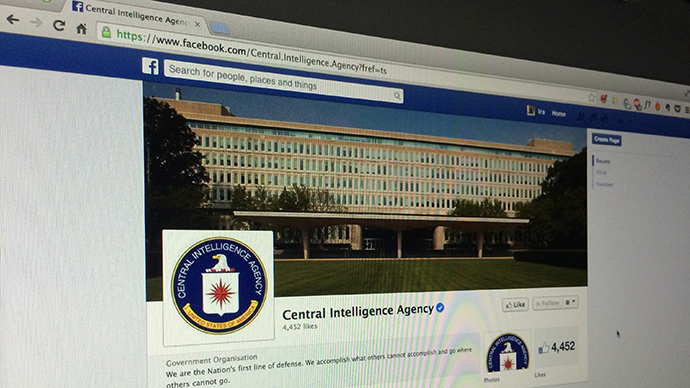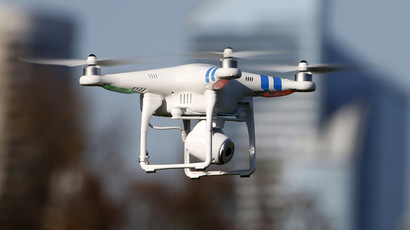CIA joins social media, is immediately trolled

Though the US Central Intelligence Agency may use Facebook, Twitter, and the like to keep tabs on targets of interest, the spy agency has only now officially joined social media--a move hastened by an imposter who was using the agency's name online.
The agency’s first tweet, which earned the CIA nearly 200,000 Twitter followers in just a few hours, was the appropriately sarcastic, “We can neither confirm nor deny that this is our first tweet.” There were already 40,000 followers after just a single hour online, with the agency's debut on Facebook sparking a similar conversation on that platform.
We can neither confirm nor deny that this is our first tweet.
— CIA (@CIA) June 6, 2014
“By expanding to these platforms, CIA will be able to more directly engage with the public and provide information on the CIA's mission, history, and other developments,” CIA Director John Brennan said in a press release Friday. “We have important insights to share, and we want to make sure that unclassified information about the agency is more accessible to the American public that we serve, consistent with our national security mission.”
The CIA admitted as far back as 2011 that its agents and employees regularly scan social media to spy on intelligence targets. It already had multiple accounts on Flickr and YouTube, but only debuted on Twitter Friday because it had spent months lobbying Twitter to stop someone else who was already using the @CIA handle.
— FBI (@FBI) June 7, 2014
“There was someone out there impersonating CIA via Twitter,” spokesperson K. Jordan Caldwell told NBC. “Earlier this year, CIA filed an impersonation complaint with Twitter and they secured the @CIA account for us, which is routine for government agencies. This has been a lengthy process. It's been in the works for a long time.”
The poser wasn't a member of the Syrian Electronic Army, or even a veteran of the agency's “enhanced interrogation” techniques, but the Cleveland Institute of Art, which was cursed with the same abbreviation as one of the most powerful cloak and dagger agencies in the world.
“We just deleted that one because it was kind of confusing,” Jessica Moore, the institute's web manager, told the Wall Street Journal. “Some people would mention us in their tweets and they were clearly thinking they were talking with the 'real CIA,' the Central Intelligence Agency.”
If the CIA is used to infiltrating foreign governments and aiding assassinations, though, it was still unprepared for Twitter trolling. Tweets immediately began pouring into the agency's timeline from all over the world. Whether it be journalists, comedians, companies, or conspiracy theorists, seemingly all of Twitter felt compelled to make a joke that had been made dozens of times before.
Seriously doubt the @CIA is only following 25 people.
— Jason Gay (@jasonWSJ) June 6, 2014
RT if you pretty much assume @CIA is following you no matter what Twitter says.
— Christopher Gorham (@ChrisGorham) June 6, 2014
.@CIA wheres that dang plane
— jonnifer lopez (@senderblock23) June 6, 2014
Certainly the most effective trolling so far has come from the New York Review of Books, which launched an assault on the CIA's Twitter feed complete with the torture methods used by the CIA and the date each incident occurred.
Each of the flurry of tweets included a link to the 2009 NY Review of Boks article titled “US Torture. Voices from the Black Sites," which “reveals for the first time the contents of a confidential Red Cross report about the CIA's secret offshore prisons.” The link was unavailable for much of the afternoon Friday, most likely because the site in question was overwhelmed with the sudden amount of traffic that came from the hundreds of retweets and favorites.
1.3.3 Beatings by use of a collar 1.3.4 Beating and kicking 1.3.5 Confinement in a box 1.3.6 Prolonged nudity @CIAhttp://t.co/iVWN7NVTrV
— NY Review of Books (@nybooks) June 6, 2014
1.3 Other Methods of Ill-treatment 1.3.1 Suffocation by water 1.3.2 Prolonged Stress Standing @CIAhttp://t.co/iVWN7NVTrV
— NY Review of Books (@nybooks) June 6, 2014
1.3.9 Prolonged use of handcuffs and shackles 1.3.10 Threats 1.3.11 Forced shaving @CIAhttp://t.co/iVWN7NVTrV
— NY Review of Books (@nybooks) June 6, 2014
Along with compelling the Cleveland Institute of Art to give up its Twitter moniker, the CIA's debut on Twitter is also timely because it comes as a number of US government agencies have increasingly relied on social media to communicate with the public. The trend began a year ago after the Edward Snowden leak, when the National Security Agency sought to shift the conversation with its own Twitter account.
“Other US government departments have attempted to use social media not only to get out their message, but at times to actively combat America's enemies in sometimes bizarre online spats,” explained Lee Ferran of ABC News. “The State Department's Think Again Turn Away Twitter account, for instance, directly engages in arguments with pro-jihadi computer users. Terrorist groups, like the Taliban and the Al-Qaeda-allied group Al-Shabab in Somalia, already have a robust social media presence, which they use to spread their own propaganda.”














